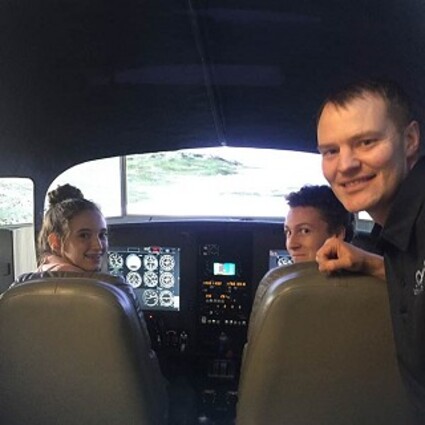Aviation students 'fly' in simulator
Last updated 1/16/2018 at Noon
The Sisters High School Aviation Program has received a Modular Flight Deck Advanced Training Flight Simulator - or "sim" in pilot-talk.
"I think we are the only high school aviation program in the country to get an FAA-certified sim," said Sheryl Yeager, FAA Certificated Flight Instructor (CFI) and SHS Flight Science teacher. "This will give our students a huge advantage in their flight training."
The sim was donated by the Aviation Department at Central Oregon Community College. While collaborating on the development of the SHS Flight Science program, Karl Baldessari, COCC Aviation Program Director, mentioned to Julie Benson, Sisters Airport owner and founder of Outlaw Aviation, that COCC was purchasing new simulators for their fixed-wing instruction.
Benson reported that she jumped at the possibility of getting one of COCC's retired simulators for use in the SHS Flight Science program, and requested the donation. It took a year for Baldessari to get approval from COCC administration to officially donate one.
Once moved to its new home in the Outlaw Aviation hangar at the Sisters Airport, the simulator required reprogramming and hardware upgrades to get it ready for students to "fly." The staff at Sisters High School was excited about the simulator, but was not able to put the work it needed into it. In another collaborative effort between SHS and Outlaw Aviation, CFIs Sam Monte and Walt Lasecki spent months replacing circuits and hardware components, and talking with technical support specialists at Precision Flight Controls to update the software and GPS module.
"Now we can program many specific scenarios for students to practice procedures they might encounter in actual flight conditions, in different locations, and different airplanes including multi-engines," said Lasecki.
Benson reported that her company Energyneering Solutions - also located at the airport - donated a trio of new screens. The screens are bigger and have better definition than the old ones, and help give the student a more realistic flight experience.
"It's interesting how much impact the visual aspect has on the students' perception," Monte observed.
"Even though the seats aren't really moving, it feels like you are. Some students even get dizzy if they lose control and spin the plane. Of course, it's much better to do that in a sim than a real airplane."
That is one advantage to training in a simulator: Students can practice maneuvers and emergency procedures safely on the ground.
Simulators are also helpful when the student is learning skills in navigation and using instruments. And the sim doesn't burn fuel, so it's more cost effective for many training exercises than a real plane.
"The FAA allows students to log up to 2.5 hours with a CFI in a certified simulator toward their private pilot requirement," Lasecki noted. "And for students going for their instrument rating, which requires a lot of practice flying only by instruments, it's even more cost effective."
Lasecki and Monte plan to make the simulator available free of charge for SHS students to use in conjunction with lessons in the Outlaw Cessna 172 trainer, and during their Wednesday-evening ground school sessions, which prepares students to take the FAA written tests.
"It will be great to use in the group sessions because the space behind the two pilots' seats is open, so other students can watch. We can do a demonstration, or when one student is at the controls, the rest of them can learn, too," said Monte.
"We can also invite parents to participate in their student's flight training by being a 'passenger' in the other sim seat," Monte added.
FAA-certified simulator time normally costs $75 per hour at traditional flight schools.
"I like that the CFI can pause the sim and discuss with the student what they're doing, there in the moment," Yeager noted. "Then they can reset the scenario and try it again, as many times as it takes for them to perform the skills proficiently. It's difficult and expensive to do that in an actual airplane. The simulator will complement the flight training they get in the 172, at a much lower cost. But, there are still some things that need to be learned in a real airplane, like what the plane is doing when you feel G-forces in your seat, or how to recognize a stall when the plane bucks."

















Reader Comments(0)